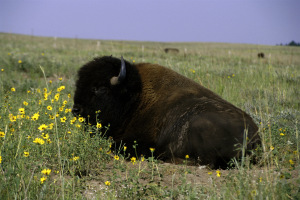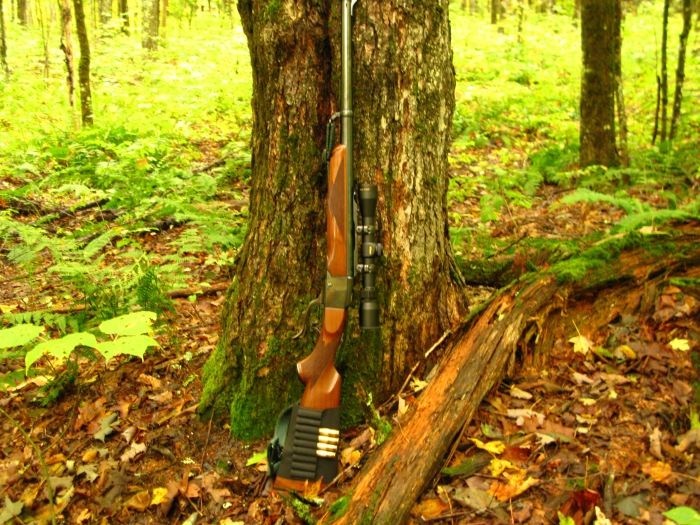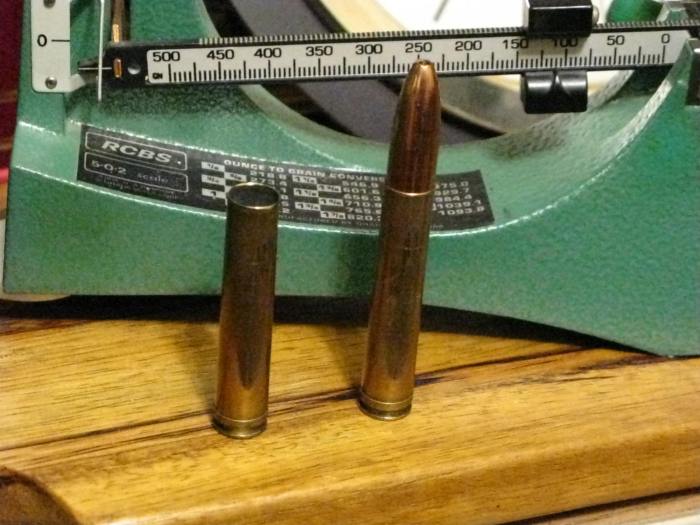Rifle Ballistics — A Closer Look – P3
Posted by bigborefan on March 18, 2019

<These bullets have distinct profiles, and the construction of each differs to varying degrees from the others. There are reasons for that.
For the purpose of this context, they are all .458″ so that we can visualize what modifications in terminal results may occur when we know their impact velocity, weight and construction.
This blog will be an attempt to understand the reasons for those differences as we focus on:
Terminal Ballistics.
A friend by the name of Dan Schindler (Paragon Sporting Inc.) went to Alaska in 2014 to shoot a black bear. He took his M70 Winchester in .458 Win Mag. It had a custom synthetic stock and a 22″ barrel. He obsessed for some time over what bullet to handload for this pursuit. In the end, he made a wise choice even though I recommended a heavier bullet. Based on first impressions, I didn’t think a CEB with a poly tip and 265 grains was the way to go when there were better — in my view. Now, it’s important to understand something about Danny: He’s a pro in every sense of the word! He’s a trainer of trainers in the shotgun sports, and a trainer of rifle shooters as well. He knows what he can do with a shotgun AND a rifle!
He hunted on Prince of Wales from a boat. (If I ever hunted Alaska, that would be my first choice – from a boat, since I was practically raised in one on the East Coast of Canada in a fishing community.) Of course, he didn’t shoot from a boat, but they (boat captain, outfitter-guide and Dan) travelled up inlets and bays looking for black bears. Also a 4×4 was used on land when appropriate. Nearing the end of the hunt, a good black bear was sighted as they rounded a bend on the 4 x 4. A stalk was made and from about 90 yards Dan pulled the trigger.

Dan sent me a report sometime after returning home. I ran a ballistic simulation profile of expected results. It turns out that he was very right in his expectations and I was very wrong! The 265gr Raptor was more than plenty for the 400 lb black bear that was terminated immediately on bullet impact. In fact, he felt that the bear was dead before it hit the ground. One and done! It was a 6′-10″ bear at 400 lbs. The bullet had taken out lungs and heart.
The following is a profile of the ballistics from Dan’s .458 Win Mag load:
Rifle: a customized M70 Winchester
Cartridge: .458 Winchester Magnum
Bullet: 265gr CEB Raptor with poly tip.
SD = .181
BC = .204
MV = 2650 fps/4132 ft-lbs/ 123 TE
90 = 2297 fps/3104 ft-lbs/ 93 TE – enough for a 1100+ lb bear at that range!
My results are based on the formula given several times in the past, including in the last blog:
Terminal Effect = KEI x SD x CSAHence: Dan’s ballistic results @ 3104 x .181 x .165 = 92.7 (x 12.5 for approximate size bear with correct shot placement from a good-appropriate bullet.) This is a guideline ONLY that I’ve used for the past few decades.
Nonetheless, it accords with a guideline that I read in a hunting magazine a number of years ago. The author’s name or even that of the magazine doesn’t come to mind, but the writer had made a trip to Alaska for grizzly, and succeeded. (Likely, his firearm was in .338 Win Mag or .375 H&H.) Anyway, I do recall his recommendation, which he felt was a minimum for that species and location: 3000 ft-lbs at impact using a good premium bullet.
Of course, “we ALL know” there’s more to it than that, but his piece likely mentioned bullet placement as well.
My “formula” is the result of extensive reviews of professional ballistic engineers’ work, plus reported results of some pros in the field, and my own field work.
It is similar to John Wootters’ formula, but was published in my manual on the .45-70 a year or so before his appeared in a Petersen publication. Subsequently, I had correspondence with him about it. The main distinction being that he used nominal caliber whereas I use cross-sectional area of bullet.
Yes, I have read the arguments against using ANY formula, plus the argument that SD of a soft-point bullet changes after impact. However, professional ballisticians, who test bullets daily, still cite and recommend SD as a significant entity at impact. But also, in comparison of one soft-nose bullet with another of the same make, it seems to me that SD still has meaning in end results if both are deformed in a similar manner or degree; whether that be that they retain 70% of un-fired weight, as in a Partition, or 100% as in a TSX. It has been rightly pointed out to me by a math guy, that the end result of my formula biases the momentum that is doubled, rather than leaning on velocity that is squared in kinetic energy, though both are implied in the formula.
And I’ve read the very in-depth piece that has appeared from time to time on the forums that attempts to debunk in an academic manner any and all ideas about kinetic energy or momentum at impact being predictable of outcome.
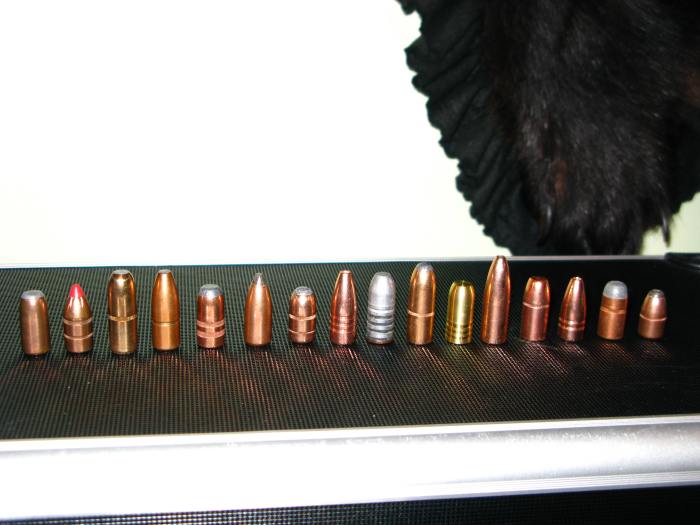
Standing alone, I agree. But also caliber, bullet weight, construction, profile and impact velocity cannot be denied as the principle components in terminal effect. And, of course, bullet placement. But bullet placement apart from the ballistics involved is meaningless! So bullet placement, while it can’t be taken for granted, is ALWAYS a variable that CANNOT be assumed under ALL conditions! Therefore it has no place in the study of IMPACT ballistics. Yes, it IS an important factor in TERMINAL EFFECT, but that is still an uncertain factor depending on the HUNTER and nothing else!
It is therefore ASSUMED in my formula that the hunter/shooter has placed the bullet correctly, whatever the conditions, and within a range where an appropriate bullet will do its work as predicted — based on impact velocity, caliber, weight (SD) and construction — that also takes account of its profile.
Now, as to the bullets that appear at the top: First row, L to R: 465gr hardcast; 400gr Barnes Buster; 330gr Barnes Banded (now out of production); 350gr TSX and 300gr TSX.
Bottom row, L to R: 400gr Hawk FP; 350gr Hornady FP; 405gr Remington;350gr Speer Hotcor; and 450gr Swift A-Frame.
What could we do with those? What would I do?
Based on some tests and experience with some on game, this is what I’d recommend:
465 hardcast – worked very well on a 6′ bear from a frontal shot. MV was 1900 fps and range was 70 yards. It was a “bang-flop” and the bullet was never found. The bear didn’t hear the sound of the rifle.
400 Buster – tests show it will penetrate, like forever.
330 Barnes Banded – penetration was complete in media, but it lost its stability and went sideways through the last plank.
350 TSX – a go-to bullet for the .458 Win. Shot a medium bear with it and wouldn’t hesitate to use it on moose or elk. Full penetration in test media and retained 100% of weight. A 500gr Speer GS penetrated 6.5″ and retained 310grs of the initial 500 = 62%. In other words the 350 TSX not only “out-penetrated” the 500 Speer, but out-weighed it as well by 40 grs at 350 to 310. The 350 went on both a moose and bear hunt.
300 TSX – used in tests with phenomenal results. Retained 100%. Also used in a bear hunt without a chance on the bear I wanted.
400 Hawk – only used for handload tests, so far. Good results, though I’d ony consider it for deer or possibly bear at no more than 1800 fps. It’s a soft bullet.
350 Hornady FP – loaded now for my Ruger Tropical in .458 at 2510 fps. Very accurate. It may be used for a bear hunt in May or September. In the same test done in November 2017, it only penetrated 4.5″ and lost its core. MV was 2250 fps and impact was at 5 yards into very tough test material — just like the others.
405 Remington – used on bear with great success from my Marlin Classic .45-70 at 2110 fps MV and impact MV about 1835 at 97 yards. Full penetration on the bear from neck-shoulder to offside flank. DRT.
350 Speer – a great .458-cal bullet for medium to heavy game. Used on one bear from my first .458 WM, a M77 Ruger, at 2345 fps MV. Range was 70 yards (est.) and penetration was complete from a going-away shot to liver and exit taking out eight inches of spine and back of head. Damage was awesome.
450 A-Frame – used only in developing loads for the CZ550, so far.
A MORE IN-DEPTH ANALYSIS
Flat- Point Jacketed Bullet:
Of the ten (up top), the five on the bottom row have lead cores with a copper, or copper alloy jacket. All have a flat point of variable diameters.
The 400 Hawk is a custom bullet ordered for me by a dealer. It’s 400 grains with a 1/35″ pure copper jacket and soft lead core. It was specifically made for a .45-70 at an MV of between 1600 and 1900 fps. The weight is ideal for white-tailed deer of any size up to about 150 yards if any expansion is wanted. However, with its broad flat tip it would still work well enough to 200 yards without expansion, where velocity would be about 1320 fps. It has a poor BC of only .214 but a relatively high SD of .272. If it were a tougher bullet, I wouldn’t hesitate to use it on moose to 250 yards. But I would also want a better BC for improved ballistics down range, and that would mean a somewhat smaller meplat (tip). That would also give better penetration.
A 405gr/.458-cal Remington. can make at least 2000 fps from a 22″ Marlin. It has a smaller meplat, a double radius bullet, and a core that’s tougher than the Hawk. The jacket is copper-alloy (tougher but thinner). Good reports have come back from use on bear and moose/elk. I used it on one bear and it worked superbly at about 100 yards — a “bang-flop” with full penetration, leaving the muzzle of my 22″ Marlin at just over 2100 fps.
But still, an ideal bullet for the Marlin might be the 400gr Swift or Woodleigh that I’ve never tried.
Why is that so? For larger game like moose or elk, or even large bears, we want penetration to or through the vitals. A tougher jacket would give better insurance as would a harder core. A .458″ bullet doesn’t need much expansion to get the job done. But a flat point tends to do more damage (depending on its width) and tracks in a straight line. 400 grains will give better penetration than a 300 or 350 with equal shape and construction due to its better momentum caused by a greater weight and SD, assuming they all are loaded to the same PSI.
The 350 Speer in .458″
This bullet was made for the .458 Win Mag and the velocities it can generate. I used it on a bear at 2345 fps (reduced load) at 70 yards and it was devastation for the bear. It has a smaller diameter point than the Hawk, Hornady or Remington, a heavier jacket with a harder core. Also, due to its smaller point, it has a better BC of .232 than the 400 Hawk and 350 Hornady, but less than the 405 Remington with a good BC of .281.
I’d not hesitate to use that bullet on moose or elk at reasonable ranges. But for big bears (black or brown), I’d choose the 350 TSX, 400 GS or even the 500 TSX — more on that upcoming.
The 450gr Swift A-Frame has a very good reputation on African and Alaskan large game, and even some of the dangerous sort. However, in my view, it’s BC could be improved at only .325. The 500 TSX is .412, and is what I’d choose for my Ruger #1 Tropical if ever a hunt in Africa or Alaska was on the agenda.
Look at these potential results:
Rifle: .458 Win Mag or any other .458-cal that could produce equal ballistics
Bullet: 500gr TSX
BC = .412
SD = .341
MV = 2300 fps (from a 24″ barrel)
Ambient average hunting conditions for my area in spring or fall:
Temp. @ 60* F/ 17* C.
Elevation @ 1150 ft
RH @ 56%
Zero @ 200 yards
MV = 2300 fps/5872 ft-lbs/330 TE/ -1.60″
50 = 2205 fps/5395 ft-lbs/303 TE/ +1.66″
100= 2112 fps/4951 ft-lbs/278 TE/ +3.12″
150= 2021 fps/4535 ft-lbs/255 TE/ +2.62″
200= 1933 fps/4148 ft-lbs/233 TE/ +0.00″
250= 1847 fps/3789 ft-lbs/213 TE/ -4.95″
300= 1764 fps/3455 ft-lbs/194 TE/ -12.4″
350= 1684 fps/3148 ft-lbs/177 TE/ -22.7″
400= 1607 fps/2867 ft-lbs/161 TE/ -36.1″ (An excellent mature bull moose load to 400 yards from any angle.)
The objective of these analysis of certain .458-cal bullets is to provide a model for evaluation of ANY bullet for medium to large game and/or dangerous game.
If you’ve carefully observed the comments made regarding various types, configurations and weights of .458″ projectiles, there are obviously various features that contribute to terminal effect.

TOUGHNESS: all else equal, a tougher bullet will hang together better against bone than a softer bullet.
SHAPE (or profile): A flat-point has to push/throw more material/molecules out of the way faster than a sharp-pointed bullet. That is true whether we are speaking of harder bullets or softer ones. Therefore a flat-point (expanding or solid) has to do more work than a more pointed bullet (expanding or non-expanding) within the same penetration distance. In doing more work it will do more damage if penetration is the same or complete. We know that from experience and/or theory.
If the flat point has to do more work, or actually does more work in the same distance and time frame, then it also releases more of its inherent kinetic energy within that distance and time frame.
I’ve experience of all that to confirm the logic and theory.
I’m not necessarily one who wants a bullet to spend all its energy inside the animal, but I do know that full penetration through the vitals is no guarantee of a so-called “bang-flop”. Nor, on the other hand, is the bullet a “failure” if it “dumps” all its energy inside the animal and doesn’t exit, as long as the vitals are involved.
CONSTRUCTION:A great deal of thought and research has gone into this subject since the first round ball was invented. And they were not necessarily lead.
Since guns and gun powder were invented for military purposes, advances in both have brought us to the modern era. Yet, above all else, bullets have earned more study and attention than the apparatus that fires them. And for good reason as it’s the bullet that kills!
Space and time will not permit a rehearsal of all that, but there’s no doubt that, on the whole, today’s projectiles are the best ever — with the qualification that some are mere copies of others that grandfathered them — the Partition for one example.
Today’s idea of a premium bullet is a heavier, or stronger, jacket with a bonded lead core, OR just a monolithic all copper or copper-alloy bullet regardless of other features such as profile, caliber and weight.
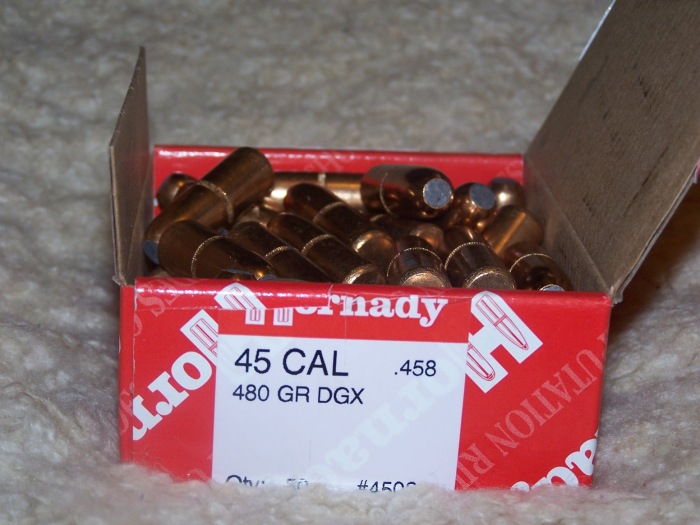
Yet Hornady makes a series of dangerous game bullets for several larger calibers with flat tips, bonded hard-lead cores in a thick steel jacket coated with a thin layer of copper for protection of the rifle’s bore! It doesn’t get much better than that for sophistication! And moreover, all they do to make one into a DGX (Dangerous Game Expanding) and the other into a DGS (Dangerous Game Solid) is reverse the bullet — the very thick steel base of the DGX becomes the solid point of the DGS!!
Then, of course, it had to happen — the “demand” for long-range shooting has all bullet makers scrambling to make the longest-sleekest-highest BC bullet possible for our hum-drum or “tricked-out” rifles. Hornady has even come out with a rifle AND ammo to meet that “demand” (really, marketing strategy!). And your guess is as good as mine as to who will be next… NEXT!! Yup, we’re already there! I just can’t wait to get my hands on one of those to shoot a bear at 50 meters!
CALIBER: does make a difference, even if we’re being told that it doesn’t matter anymore because “smaller” can do better than what “bigger” used to do anyway because of better bullets, rifles and fancier cartridges. REALLY???
Personally, I don’t buy it even though there’s a smidgen of truth therein.
Hornady’s “new” rifle and caliber is another .300 magnum with a very long throat, and action to match, to shoot their very long and aerodynamic 212gr at nearly 3000 fps so that hunters can fill their elk tags at a mile away!
If I recall correctly, I think that has already been tried by some fanciers of the .50 BMG! How many elk are you aware of that have been successfully harvested (found and brought home) at such an unforgiving range? But Hornady is making it easier from a rifle that only “kicks” like a .300 magnum!
I’ve written much previously about my thoughts on caliber, so will not bore somebody to tears by rehashing the fact that CALIBER COUNTS in there somewhere when we consider TERMINAL RESULTS!

< A 232gr Oryx vs a 286gr Partition. The Oryx has an SD of .246 and the Partition an SD of .307. Both are 9.3mm bullets. I’d count on the Partition for penetration over the Oryx — and have.)
WEIGHT:The greater the weight of a bullet in relation to caliber, the greater its SD (sectional density). All things equal, BC is improved, momentum is greater as well as penetration. Example: a 200gr Nosler Partition will penetrate better from a 30-06 than a 180gr due to the improvements mentioned. The 200 has a better SD and BC as well as more momentum, even IF KE is the same. The SD of the 200 is .301 vs .271 of the 180, and the BC is .481 vs .474. That’s assuming they each were started with equal PSI. Nosler’s manual #6 gives the 180gr 2872 fps, and the 200gr 2688 fps which gives the 200 a 5% advantage in momentum at the start that will increase down range due to a better BC. A slight edge goes to the 180 in KE at the start, but the 200 will soon catch up and pass it in KE downrange. The difference isn’t much but any advantage of one over the other goes to the 200gr. But the often forgotten bullet weight in .30-06 is the 220gr. If I were hunting the “big” bears of Alaska with a .30-06, this is the one I’d choose because of more weight granting an increase in momentum and a significant increase in SD at .331, meaning better penetration on an angling shot if needed, or perhaps a close-in shot for stopping a bear’s charge. A .30-06 wouldn’t be my first choice, but it will work at closer ranges when a Nosler 200 or 220 is employed with a steady hand. Test it with my formula and you’ll see that Phil Shoemaker is sane in what he has stated about the .30-06 in his experience. It’s unwise to debate with him other than the fact that he is an expert rifleman as well as an expert with a handgun. But also keep in mind that you and I are not his equals in these matters. He still favors his “Ole Ugly” in .458 Win Mag when he has to go into the “pucker brush” for a confrontation with a wounded brownie or grizzly. Personally, I’d start with a .458 Win.
IMPACT VELOCITY:also counts! How much has been debated “forever”. I’ve a target single-shot pellet pistol in .17-cal. It shoots .17-cal pellets at just over 400 fps. I tried to shoot a rabbit with it that was creating havoc in our veggie garden… The rabbit was unharmed with body shots that appeared to only have “bounced off” its fur and hide.
Our son, Phil, has a heavy-barrelled .17 Hornet that shoots 20gr – 25gr varmint bullets at between 3200 fps (25gr) and 3700 fps (20gr).
Would debating the issue of whether to take an air pistol that shoots .177 cal pellets at 400 fps or a .17 cal Hornet that shoots 25gr at 3200 fps for rabbits make any sense?
So, velocity counts in a hunting context.
In a small bore, such as a .223 Remingtom, a velocity difference of 200 fps from a 53gr might make a difference on a woodchuck at 300 yards. But in shooting at a woodchuck at 400 yards, a .22-250 would be a better choice because of higher velocity at impact as well as a flatter trajectory in shooting 50 to 55gr suited to the task. At 100 yards, a .22LR high velocity, like the 40gr CCI Velocitor will terminate a chuck just as dead and quickly as a .22-250… with a HEAD shot!
Those are mere examples to make a point: when we move on to large calibers, a difference of 200 fps amounts to a significant difference from a 500gr. At 2000 fps it’s making 4440 ft-lbs at the muzzle, while at 2200 fps it’s 5373 ft-lbs. That’s a difference of 933 ft-lbs or more than twice the kinetic energy of a 45 Auto 1911 at the muzzle!
In comparing a .308 Winchester to a .300 Win Mag, when handloaded with identical 180gr projectiles, the distinction in muzzle energy is about 1000 ft-lbs at the muzzle and still 700 ft-lbs difference at 300 yards in favor of the .300 Win. Would velocity make a difference in that scenario if the only shot on a 1200 lb moose on the last day would be a quartering-away-shot? Which would you rather have in your hands, the .308 or the .300?
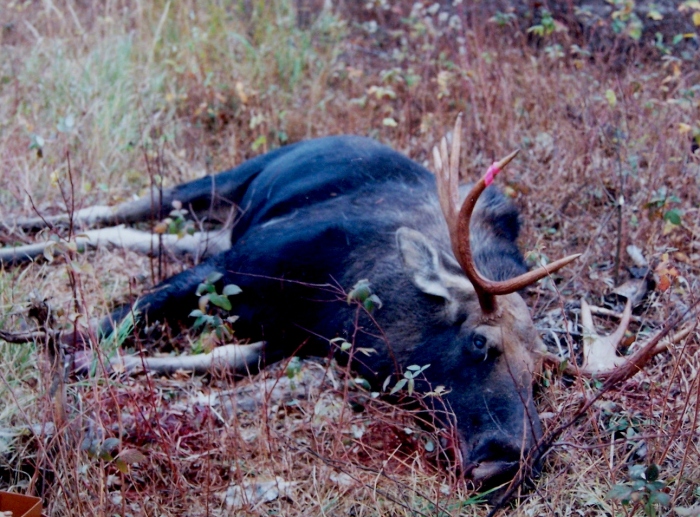
<(Moose shot in N. Ontario where possible ranges varied from a few feet to over 600 yards)
Sure, if we knew before the fact that all shooting would be at woods ranges, then a .308 Winchester would be perfect! Even a .30-30 with a good bullet in the right place. But a .30-30 on a running moose at 80 yards isn’t going to be any picnic! “C’mon back tomorrow!” “But today is the LAST day of the hunt!”
VELOCITY COUNTS!
Til the next…
Shalom
BOB MITCHELL
www.bigbores.ca 